Biermann Ch. Handbook of Pulping and Papermaking
Подождите немного. Документ загружается.

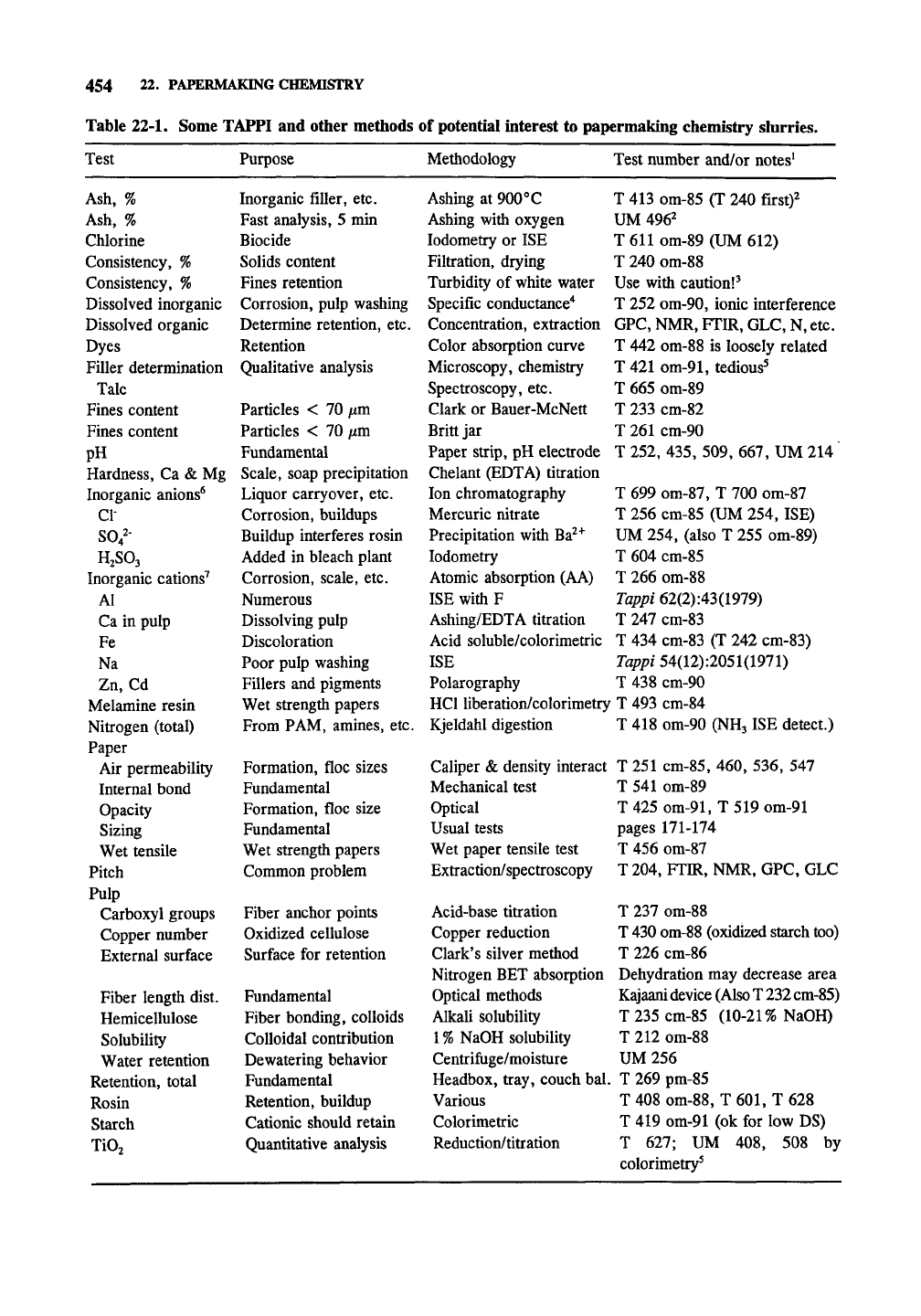
454 22. PAPERMAKING CHEMISTRY
Table 22-1. Some TAPPI and other methods of potential interest to papermaking chemistry slurries.
Test Purpose Methodology
Test number and/or notes^
Ash, %
Ash, %
Chlorine
Consistency, %
Consistency, %
Dissolved inorganic
Dissolved organic
Dyes
Filler determination
Talc
Fines content
Fines content
pH
Hardness, Ca & Mg
Inorganic anions^
cr
SO42
H2SO3
Inorganic cations''
Al
Ca in pulp
Fe
Na
Zn, Cd
Melamine resin
Nitrogen (total)
Paper
Air permeability
Internal bond
Opacity
Sizing
Wet tensile
Pitch
Pulp
Carboxyl groups
Copper number
External surface
Inorganic filler, etc.
Fast analysis, 5 min
Biocide
Solids content
Fines retention
Corrosion, pulp washing
Determine retention, etc.
Retention
Qualitative analysis
Particles < 70 ptm
Particles < 70 fim
Fundamental
Scale, soap precipitation
Liquor carryover, etc.
Corrosion, buildups
Buildup interferes rosin
Added in bleach plant
Corrosion, scale, etc.
Numerous
Dissolving pulp
Discoloration
Poor pulp washing
Fillers and pigments
Wet strength papers
From PAM, amines, etc.
Formation, floe sizes
Fundamental
Formation, floe size
Fundamental
Wet strength papers
Common problem
Fiber anchor points
Oxidized cellulose
Surface for retention
Fiber length dist. Fundamental
Hemicellulose
Solubility
Water retention
Retention, total
Rosin
Starch
TiO,
Fiber bonding, colloids
Colloidal contribution
Dewatering behavior
Fundamental
Retention, buildup
Cationic should retain
Quantitative analysis
Ashing at 900°C
Ashing with oxygen
lodometry or ISE
Filtration, drying
Turbidity of white water
Specific conductance'*
Concentration, extraction
Color absorption curve
Microscopy, chemistry
Spectroscopy, etc.
Clark or Bauer-McNett
Britt jar
Paper strip, pH electrode
Chelant (EDTA) titration
Ion chromatography
Mercuric nitrate
Precipitation with Ba^"^
lodometry
Atomic absorption (AA)
ISE with F
Ashing/EDTA titration
Acid soluble/colorimetric
ISE
Polarography
HCl liberation/colorimetry
Kjeldahl digestion
T 413 om-85 (T 240 first)^
UM 496^
T611om-89(UM612)
T 240 om-88
Use with caution!^
T 252 om-90, ionic interference
GPC,
NMR, FTIR, GLC,
N,
etc.
T 442 om-88 is loosely related
T421
om-91,
tedious^
T 665 om-89
T 233 cm-82
T
261
cm-90
T 252, 435, 509, 667, UM 214
T 699 om-87, T 700 om-87
T 256 cm-85 (UM 254, ISE)
UM 254, (also T 255 om-89)
T 604 cm-85
T 266 om-88
Tappi
62(2):43(1979)
T 247 cm-83
T 434 cm-83 (T 242 cm-83)
Tappi
54(12):2051(1971)
T 438 cm-90
T 493 cm-84
T 418 om-90 (NH3 ISE detect.)
Caliper & density interact T
251
cm-85, 460, 536, 547
Mechanical test
Optical
Usual tests
Wet paper tensile test
Extraction/spectroscopy
Acid-base titration
Copper reduction
Clark's silver method
Nitrogen BET absorption
Optical methods
Alkali solubility
1%
NaOH solubility
Centrifiige/moisture
Headbox, tray, couch bal.
Various
Colorimetric
Reduction/titration
T 541 om-89
T 425
om-91,
T 519 om-91
pages 171-174
T 456 om-87
T204,
FTIR, NMR, GPC, GLC
T 237 om-88
T
430
om-88 (oxidized starch too)
T 226 cm-86
Dehydration may decrease area
Kajaani device
(Also
T
232 cm-85)
T 235 cm-85
(10-21%
NaOH)
T 212 om-88
UM256
T 269 pm-85
T 408 om-88, T
601,
T 628
T 419
om-91
(ok for low DS)
T 627; UM 408, 508 by
colorimetry^
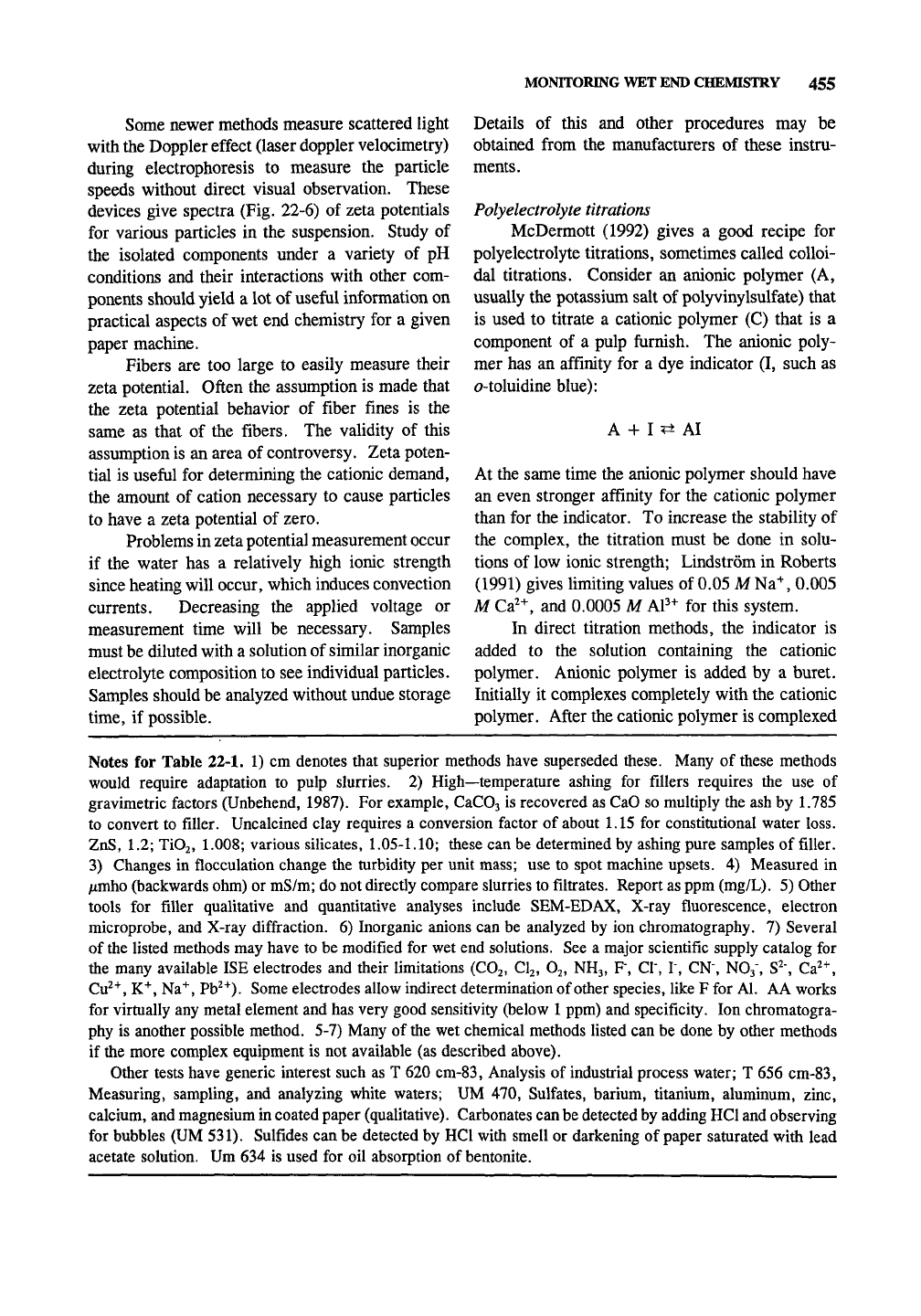
MONITORING WET END CHEMISTRY 455
Some newer methods measure scattered light
with the Doppler effect (laser doppler velocimetry)
during electrophoresis to measure the particle
speeds without direct visual observation. These
devices give spectra (Fig. 22-6) of zeta potentials
for various particles in the suspension. Study of
the isolated components under a variety of pH
conditions and their interactions with other com-
ponents should yield a lot of useful information on
practical aspects of wet end chemistry for a given
paper machine.
Fibers are too large to easily measure their
zeta potential. Often the assumption is made that
the zeta potential behavior of fiber fines is the
same as that of the fibers. The validity of this
assumption is an area of controversy. Zeta poten-
tial is useful for determining the cationic demand,
the amount of cation necessary to cause particles
to have a zeta potential of zero.
Problems in zeta potential measurement occur
if the water has a relatively high ionic strength
since heating will occur, which induces convection
currents. Decreasing the applied vohage or
measurement time will be necessary. Samples
must
be
diluted with a solution of similar inorganic
electrolyte composition to see individual particles.
Samples should be analyzed without undue storage
time,
if possible.
Details of this and other procedures may be
obtained from the manufacturers of these instru-
ments.
Polyelectrolyte titrations
McDermott (1992) gives a good recipe for
polyelectrolyte titrations, sometimes called colloi-
dal titrations. Consider an anionic polymer (A,
usually the potassium salt of polyvinylsulfate) that
is used to titrate a cationic polymer (C) that is a
component of a pulp furnish. The anionic poly-
mer has an affinity for a dye indicator (I, such as
o-toluidine blue):
A + I ?^ AI
At the same time the anionic polymer should have
an even stronger affinity for the cationic polymer
than for the indicator. To increase the stability of
the complex, the titration must be done in solu-
tions of low ionic strength; Lindstrom in Roberts
(1991) gives limiting values of 0.05 MNa^,
0.005
M Ca^+, and
0.0005
M AP+ for this system.
In direct titration methods, the indicator is
added to the solution containing the cationic
polymer. Anionic polymer is added by a buret.
Initially it complexes completely with the cationic
polymer. After the cationic polymer is complexed
Notes for Table 22-1. 1) cm denotes that superior methods have superseded these. Many of these methods
would require adaptation to pulp slurries. 2) High—temperature ashing for fillers requires the use of
gravimetric factors (Unbehend, 1987). For example, CaCOj is recovered as CaO so multiply the ash by 1.785
to convert to filler. Uncalcined clay requires a conversion factor of about 1.15 for constitutional water loss.
ZnS,
1.2;
TiOj,
1.008;
various silicates,
1.05-1.10;
these can be determined by ashing pure samples of filler.
3) Changes in
flocculation
change the turbidity per unit mass; use to spot machine upsets. 4) Measured in
/xmho (backwards ohm) or mS/m; do not directly compare slurries to filtrates. Report as ppm (mg/L). 5) Other
tools for filler qualitative and quantitative analyses include SEM-EDAX, X-ray fluorescence, electron
microprobe, and X-ray diffraction. 6) Inorganic anions can be analyzed by ion chromatography. 7) Several
of
the
listed methods may have to be modified for wet end solutions. See a major scientific supply catalog for
the many available ISE electrodes and their limitations (CO2, CI2, O2, NH3, F, CI", T, CN', NOj", S^', Ca^^,
Cu^"*",
K^, Na"^, Pb^^). Some electrodes allow indirect determination of other species, like F for
Al.
AA works
for virtually any metal element and has very good sensitivity (below
1
ppm) and specificity. Ion chromatogra-
phy is another possible method. 5-7) Many of
the
wet chemical methods listed can be done by other methods
if the more complex equipment is not available (as described above).
Other tests have generic interest such as T 620
cm-83.
Analysis of industrial process water; T 656
cm-83.
Measuring, sampling, and analyzing white waters; UM 470, Sulfates, barium, titanium, aluminum, zinc,
calcium, and magnesium
in
coated paper (qualitative). Carbonates
can be
detected
by
adding HCl and observing
for bubbles (UM 531). Sulfides can be detected by HCl with smell or darkening of paper saturated with lead
acetate solution. Um 634 is used for oil absorption of bentonite.
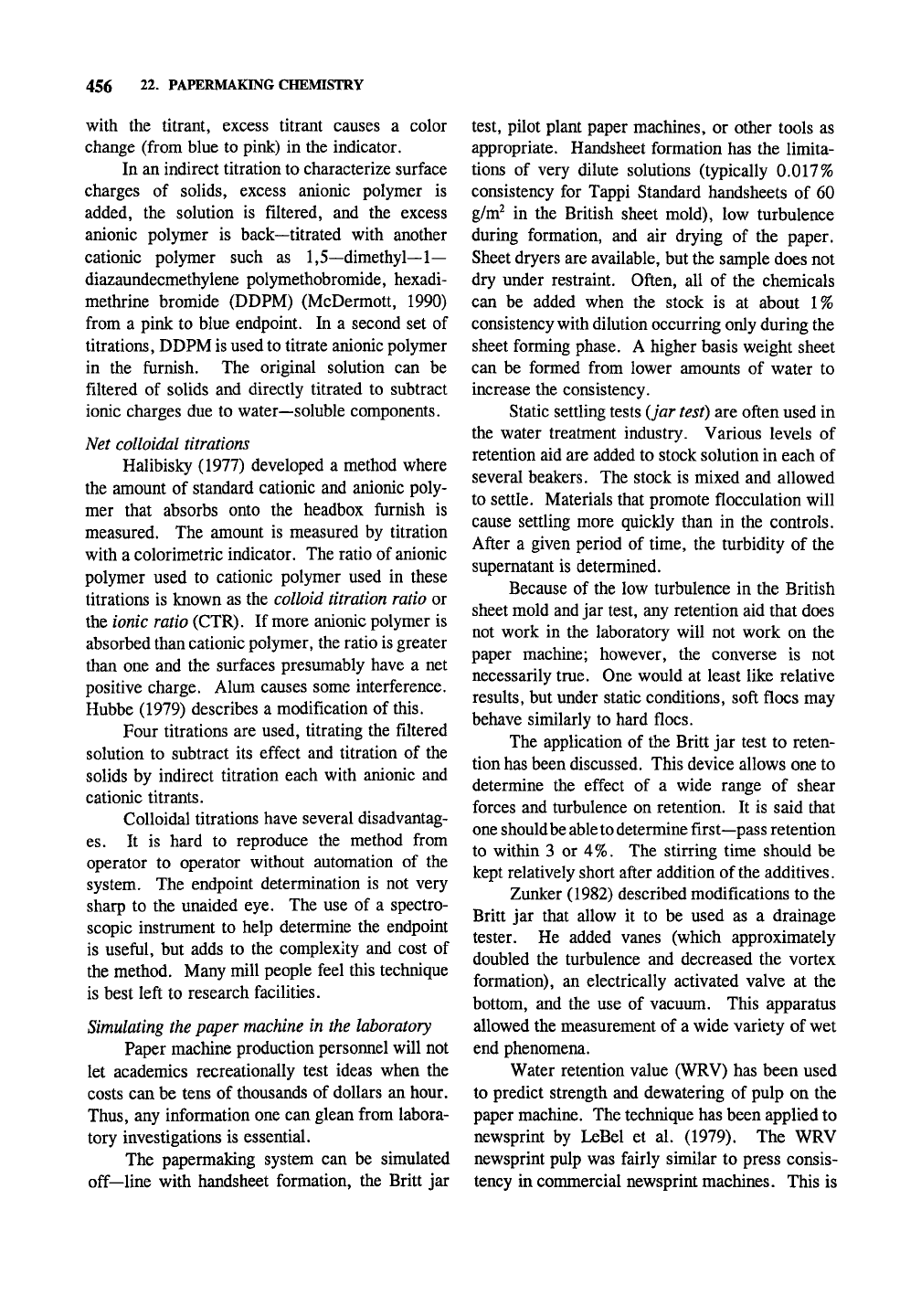
456 22. PAPERMAKING CHEMISTRY
with the titrant, excess titrant causes a color
change (from blue to pink) in the indicator.
In an indirect titration to characterize surface
charges of solids, excess anionic polymer is
added, the solution is filtered, and the excess
anionic polymer is back—titrated with another
cationic polymer such as l,5~dimethyl—1—
diazaundecmethylene polymethobromide, hexadi-
methrine bromide (DDPM) (McDermott, 1990)
from a pink to blue endpoint. In a second set of
titrations, DDPM is used to titrate anionic polymer
in the furnish. The original solution can be
filtered of solids and directly titrated to subtract
ionic charges due to water—soluble components.
Net colloidal titrations
Halibisky (1977) developed a method where
the amount of standard cationic and anionic poly-
mer that absorbs onto the headbox furnish is
measured. The amount is measured by titration
with a colorimetric indicator. The ratio of anionic
polymer used to cationic polymer used in these
titrations is known as the colloid titration ratio or
the ionic ratio (CTR). If more anionic polymer is
absorbed than cationic polymer, the ratio is greater
than one and the surfaces presumably have a net
positive charge. Alum causes some interference.
Hubbe (1979) describes a modification of this.
Four titrations are used, titrating the filtered
solution to subtract its effect and titration of the
solids by indirect titration each with anionic and
cationic titrants.
Colloidal titrations have several disadvantag-
es.
It is hard to reproduce the method from
operator to operator without automation of the
system. The endpoint determination is not very
sharp to the unaided eye. The use of a spectro-
scopic instrument to help determine the endpoint
is useful, but adds to the complexity and cost of
the method. Many mill people feel this technique
is best left to research facilities.
Simulating the paper machine in the laboratory
Paper machine production personnel will not
let academics recreationally test ideas when the
costs can be tens of thousands of dollars an hour.
Thus,
any information one can glean from labora-
tory investigations is essential.
The papermaking system can be simulated
off—line with handsheet formation, the Britt jar
test, pilot plant paper machines, or other tools as
appropriate. Handsheet formation has the limita-
tions of very dilute solutions (typically 0.017%
consistency for Tappi Standard handsheets of 60
g/m^ in the British sheet mold), low turbulence
during formation, and air drying of the paper.
Sheet dryers are available, but the sample does not
dry under restraint. Often, all of the chemicals
can be added when the stock is at about 1%
consistency with dilution occurring only during the
sheet forming phase. A higher basis weight sheet
can be formed from lower amounts of water to
increase the consistency.
Static settling tests {jar test) are often used in
the water treatment industry. Various levels of
retention aid are added to stock solution in each of
several beakers. The stock is mixed and allowed
to settle. Materials that promote flocculation will
cause settling more quickly than in the controls.
After a given period of time, the turbidity of the
supernatant is determined.
Because of the low turbulence in the British
sheet mold and jar test, any retention aid that does
not work in the laboratory will not work on the
paper machine; however, the converse is not
necessarily true. One would at least like relative
results, but under static conditions, soft floes may
behave similarly to hard floes.
The application of the Britt jar test to reten-
tion has been discussed. This device allows one to
determine the effect of a wide range of shear
forces and turbulence on retention. It is said that
one should
be
able to determine first—pass retention
to within 3 or 4%. The stirring time should be
kept relatively short after addition of the additives.
Zunker (1982) described modifications to the
Britt jar that allow it to be used as a drainage
tester. He added vanes (which approximately
doubled the turbulence and decreased the vortex
formation), an electrically activated valve at the
bottom, and the use of vacuum. This apparatus
allowed the measurement of a wide variety of wet
end phenomena.
Water retention value (WRV) has been used
to predict strength and dewatering of pulp on the
paper machine. The technique has been applied to
newsprint by LeBel et al. (1979). The WRV
newsprint pulp was fairly similar to press consis-
tency in commercial newsprint machines. This is
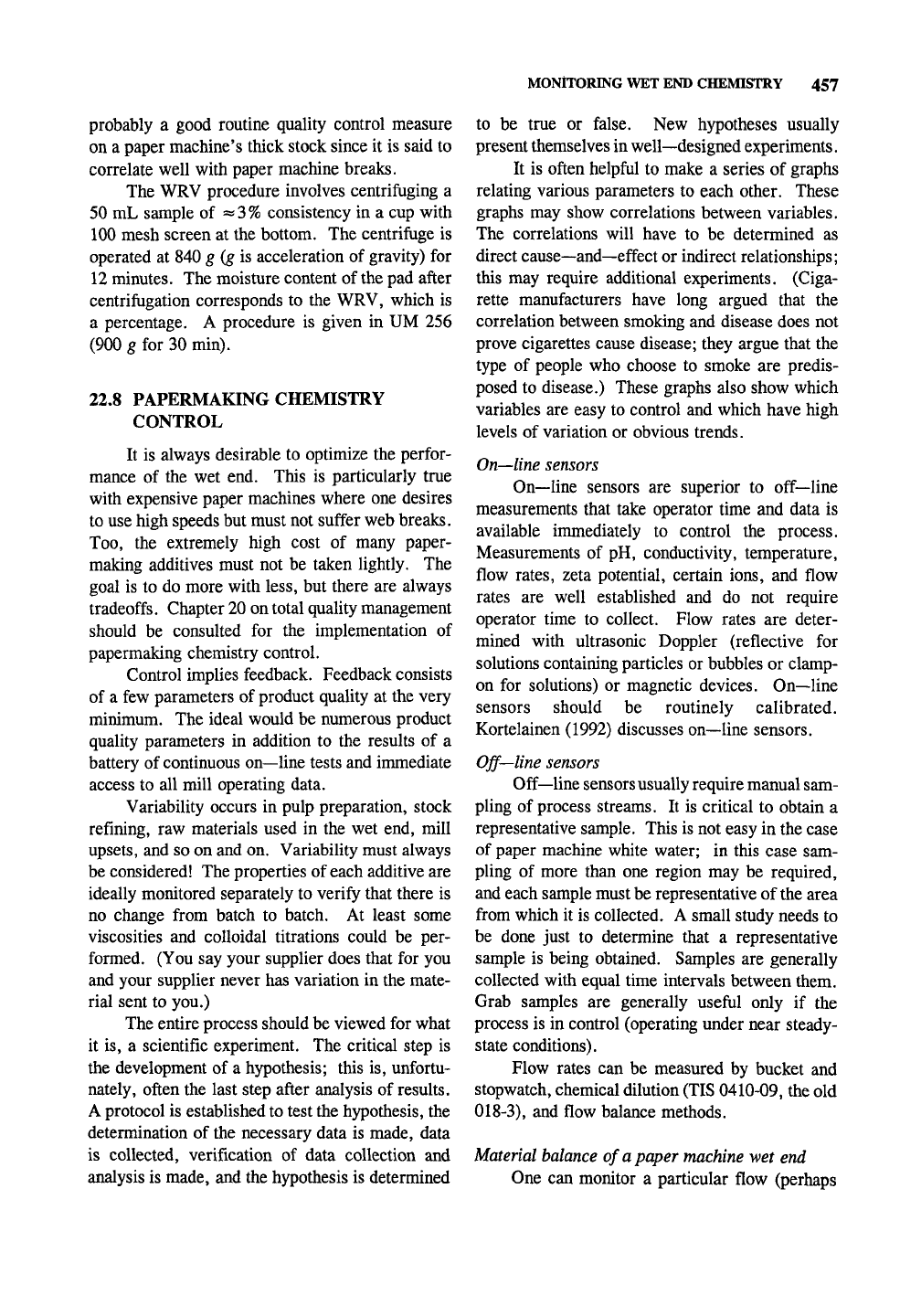
MONITORING WET END CHEMISTRY 457
probably a good routine quality control measure
on a paper machine's thick stock since it is said to
correlate well with paper machine breaks.
The WRV procedure involves centrifuging a
50 mL sample of »3% consistency in a cup with
100 mesh screen at the bottom. The centrifuge is
operated at 840 g (g is acceleration of gravity) for
12 minutes. The moisture content of
the
pad after
centrifugation corresponds to the WRV, which is
a percentage. A procedure is given in UM 256
(900 g for 30 min).
22.8 PAPERMAKING CHEMISTRY
CONTROL
It is always desirable to optimize the perfor-
mance of the wet end. This is particularly true
with expensive paper machines where one desires
to use high speeds but must not suffer web breaks.
Too,
the extremely high cost of many paper-
making additives must not be taken lightly. The
goal is to do more with less, but there are always
tradeoffs. Chapter 20 on total quality management
should be consulted for the implementation of
papermaking chemistry control.
Control implies feedback. Feedback consists
of a few parameters of product quality at the very
minimum. The ideal would be numerous product
quality parameters in addition to the results of a
battery of continuous on—line tests and immediate
access to all mill operating data.
Variability occurs in pulp preparation, stock
refining, raw materials used in the wet end, mill
upsets, and so on and on. Variability must always
be considered! The properties of each additive are
ideally monitored separately to verify that there is
no change from batch to batch. At least some
viscosities and colloidal titrations could be per-
formed. (You say your supplier does that for you
and your supplier never has variation in the mate-
rial sent to you.)
The entire process should be viewed for what
it is, a scientific experiment. The critical step is
the development of a hypothesis; this is, unfortu-
nately, often the last step after analysis of results.
A protocol is established to test the hypothesis, the
determination of the necessary data is made, data
is collected, verification of data collection and
analysis is made, and the hypothesis is determined
to be true or false. New hypotheses usually
present themselves in well—designed experiments.
It is often helpful to make a series of graphs
relating various parameters to each other. These
graphs may show correlations between variables.
The correlations will have to be determined as
direct cause—and—effect or indirect relationships;
this may require additional experiments. (Ciga-
rette manufacturers have long argued that the
correlation between smoking and disease does not
prove cigarettes cause disease; they argue that the
type of people who choose to smoke are predis-
posed to disease.) These graphs also show which
variables are easy to control and which have high
levels of variation or obvious trends.
On—line sensors
On—line sensors are superior to off-line
measurements that take operator time and data is
available immediately to control the process.
Measurements of pH, conductivity, temperature,
flow
rates,
zeta potential, certain ions, and flow
rates are well established and do not require
operator time to collect. Flow rates are deter-
mined with ultrasonic Doppler (reflective for
solutions containing particles or bubbles or clamp-
on for solutions) or magnetic devices. On—line
sensors should be routinely calibrated.
Kortelainen (1992) discusses on—line sensors.
Off-line sensors
Off—line sensors usually require manual sam-
pling of process streams. It is critical to obtain a
representative sample. This is not easy in the case
of paper machine white water; in this case sam-
pling of more than one region may be required,
and each sample must be representative of
the
area
from which it is collected. A small study needs to
be done just to determine that a representative
sample is being obtained. Samples are generally
collected with equal time intervals between them.
Grab samples are generally useful only if the
process is in control (operating under near steady-
state conditions).
Flow rates can be measured by bucket and
stopwatch, chemical dilution
(TIS
0410-09, the old
018-3),
and flow balance methods.
Material balance of a paper machine wet end
One can monitor a particular flow (perhaps
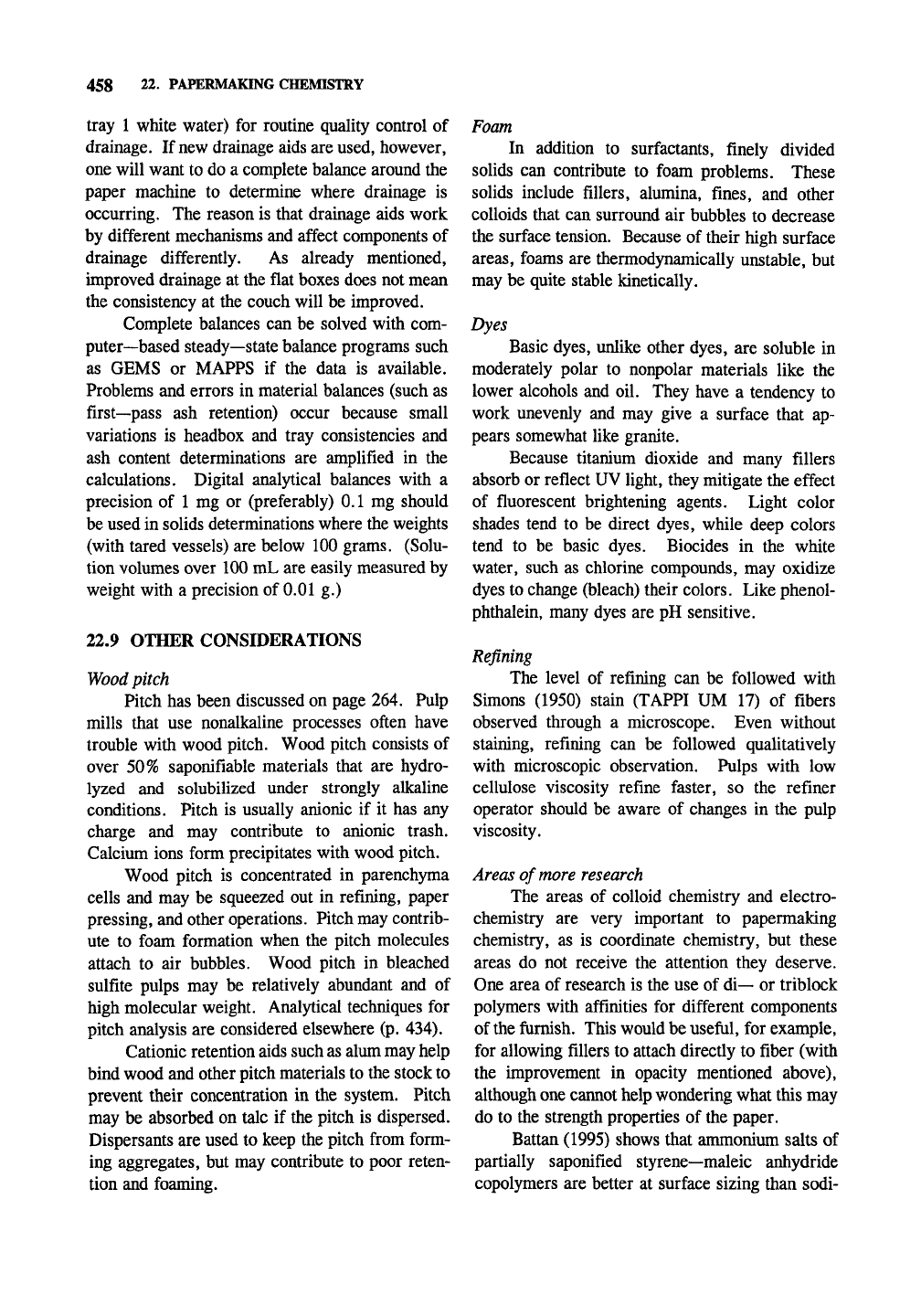
458 22. PAPERMAKING CHEMISTRY
tray 1 white water) for routine quality control of
drainage. If new drainage aids are used, however,
one will want to do a complete balance around the
paper machine to determine where drainage is
occurring. The reason is that drainage aids work
by different mechanisms and affect components of
drainage differently. As already mentioned,
improved drainage at the flat boxes does not mean
the consistency at the couch will be improved.
Complete balances can be solved with com-
puter—based steady—state balance programs such
as GEMS or MAPPS if the data is available.
Problems and errors in material balances (such as
first—pass ash retention) occur because small
variations is headbox and tray consistencies and
ash content determinations are amplified in the
calculations. Digital analytical balances with a
precision of 1 mg or (preferably) 0.1 mg should
be used in solids determinations where the weights
(with tared vessels) are below 100 grams. (Solu-
tion volumes over 100 mL are easily measured by
weight with a precision of 0.01 g.)
22.9 OTHER CONSIDERATIONS
Wood
pitch
Pitch has been discussed on page 264. Pulp
mills that use nonalkaline processes often have
trouble with wood pitch. Wood pitch consists of
over 50% saponifiable materials that are hydro-
lyzed and solubilized under strongly alkaline
conditions. Pitch is usually anionic if it has any
charge and may contribute to anionic trash.
Calcium ions form precipitates with wood pitch.
Wood pitch is concentrated in parenchyma
cells and may be squeezed out in refining, paper
pressing, and other operations. Pitch may contrib-
ute to foam formation when the pitch molecules
attach to air bubbles. Wood pitch in bleached
sulfite pulps may be relatively abundant and of
high molecular weight. Analytical techniques for
pitch analysis are considered elsewhere (p. 434).
Cationic retention aids such as alum may help
bind wood and other pitch materials to the stock to
prevent their concentration in the system. Pitch
may be absorbed on talc if the pitch is dispersed.
Dispersants are used to keep the pitch from form-
ing aggregates, but may contribute to poor reten-
tion and foaming.
Foam
In addition to surfactants, finely divided
solids can contribute to foam problems. These
solids include fillers, alumina, fines, and other
colloids that can surround air bubbles to decrease
the surface tension. Because of their high surface
areas,
foams are thermodynamically unstable, but
may be quite stable kinetically.
Dyes
Basic dyes, unlike other dyes, are soluble in
moderately polar to nonpolar materials like the
lower alcohols and oil. They have a tendency to
work unevenly and may give a surface that ap-
pears somewhat like granite.
Because titanium dioxide and many fillers
absorb or reflect UV light, they mitigate the effect
of fluorescent brightening agents. Light color
shades tend to be direct dyes, while deep colors
tend to be basic dyes. Biocides in the white
water, such as chlorine compounds, may oxidize
dyes to change (bleach) their colors. Like phenol-
phthalein, many dyes are pH sensitive.
Refining
The level of refining can be followed with
Simons (1950) stain (TAPPI UM 17) of fibers
observed through a microscope. Even without
staining, refining can be followed qualitatively
with microscopic observation. Pulps with low
cellulose viscosity refine faster, so the refiner
operator should be aware of changes in the pulp
viscosity.
Areas of more research
The areas of colloid chemistry and electro-
chemistry are very important to papermaking
chemistry, as is coordinate chemistry, but these
areas do not receive the attention they deserve.
One area of research is the use of di— or triblock
polymers with affinities for different components
of
the
furnish. This would be useful, for example,
for allowing fillers to attach directly to fiber (with
the improvement in opacity mentioned above),
although one cannot help wondering what this may
do to the strength properties of the paper.
Battan (1995) shows that ammonium salts of
partially saponified styrene—maleic anhydride
copolymers are better at surface sizing than sodi-
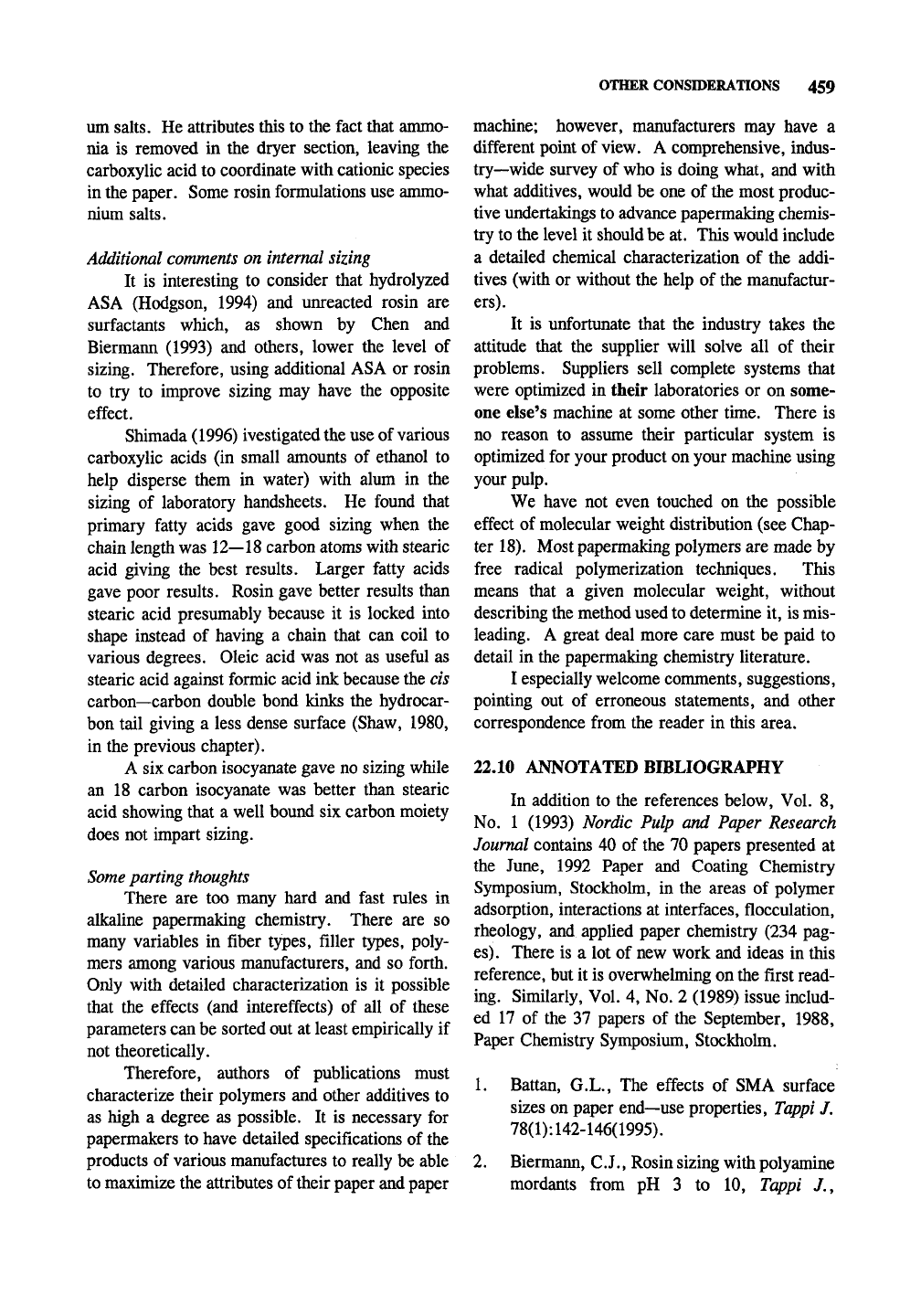
OTHER CONSIDERATIONS 459
um salts. He attributes this to the fact that ammo-
nia is removed in the dryer section, leaving the
carboxylic acid to coordinate with cationic species
in the paper. Some rosin formulations use ammo-
nium salts.
Additional comments on internal sizing
It is interesting to consider that hydrolyzed
ASA (Hodgson, 1994) and unreacted rosin are
surfactants which, as shown by Chen and
Biermann (1993) and others, lower the level of
sizing. Therefore, using additional ASA or rosin
to try to improve sizing may have the opposite
effect.
Shimada (1996) ivestigated the use of various
carboxylic acids (in small amounts of ethanol to
help disperse them in water) with alum in the
sizing of laboratory handsheets. He found that
primary fatty acids gave good sizing when the
chain length was 12—18 carbon atoms with stearic
acid giving the best results. Larger fatty acids
gave poor results. Rosin gave better results than
stearic acid presumably because it is locked into
shape instead of having a chain that can coil to
various degrees. Oleic acid was not as useful as
stearic acid against formic acid ink because the cis
carbon—carbon double bond kinks the hydrocar-
bon tail giving a less dense surface (Shaw, 1980,
in the previous chapter).
A six carbon isocyanate gave no sizing while
an 18 carbon isocyanate was better than stearic
acid showing that a well bound six carbon moiety
does not impart sizing.
Some
parting thoughts
There are too many hard and fast rules in
alkaline papermaking chemistry. There are so
many variables in fiber types, filler types, poly-
mers among various manufacturers, and so forth.
Only with detailed characterization is it possible
that the effects (and intereffects) of all of these
parameters can be sorted out at least empirically if
not theoretically.
Therefore, authors of publications must
characterize their polymers and other additives to
as high a degree as possible. It is necessary for
papermakers to have detailed specifications of the
products of various manufactures to really be able
to maximize the attributes of their paper and paper
machine; however, manufacturers may have a
different point of view. A comprehensive, indus-
try—wide survey of who is doing what, and with
what additives, would be one of the most produc-
tive undertakings to advance papermaking chemis-
try to the level it should be at. This would include
a detailed chemical characterization of the addi-
tives (with or without the help of the manufactur-
ers).
It is unfortunate that the industry takes the
attitude that the supplier will solve all of their
problems. Suppliers sell complete systems that
were optimized in their laboratories or on some-
one else's machine at some other time. There is
no reason to assume their particular system is
optimized for your product on your machine using
your pulp.
We have not even touched on the possible
effect of molecular weight distribution (see Chap-
ter 18). Most papermaking polymers are made by
free radical polymerization techniques. This
means that a given molecular weight, without
describing the method used to determine it, is mis-
leading. A great deal more care must be paid to
detail in the papermaking chemistry literature.
I especially welcome conmients, suggestions,
pointing out of erroneous statements, and other
correspondence from the reader in this area.
22.10 AlSfNOTATED BIBLIOGRAPHY
In addition to the references below. Vol. 8,
No.
1 (1993) Nordic Pulp and Paper Research
Journal contains 40 of the 70 papers presented at
the June, 1992 Paper and Coating Chemistry
Symposium, Stockholm, in the areas of polymer
adsorption, interactions at interfaces, flocculation,
rheology, and applied paper chemistry (234 pag-
es).
There is a lot of new work and ideas in this
reference, but it is overwhelming on the first read-
ing. Similarly, Vol. 4, No. 2 (1989) issue includ-
ed 17 of the 37 papers of the September, 1988,
Paper Chemistry Symposium, Stockholm.
1.
Battan, G.L., The effects of SMA surface
sizes on paper end—use properties,
Tappi
J,
78(1):
142-146(1995).
2.
Biermann, C.J., Rosin sizing with polyamine
mordants from pH 3 to 10, Tappi /.,
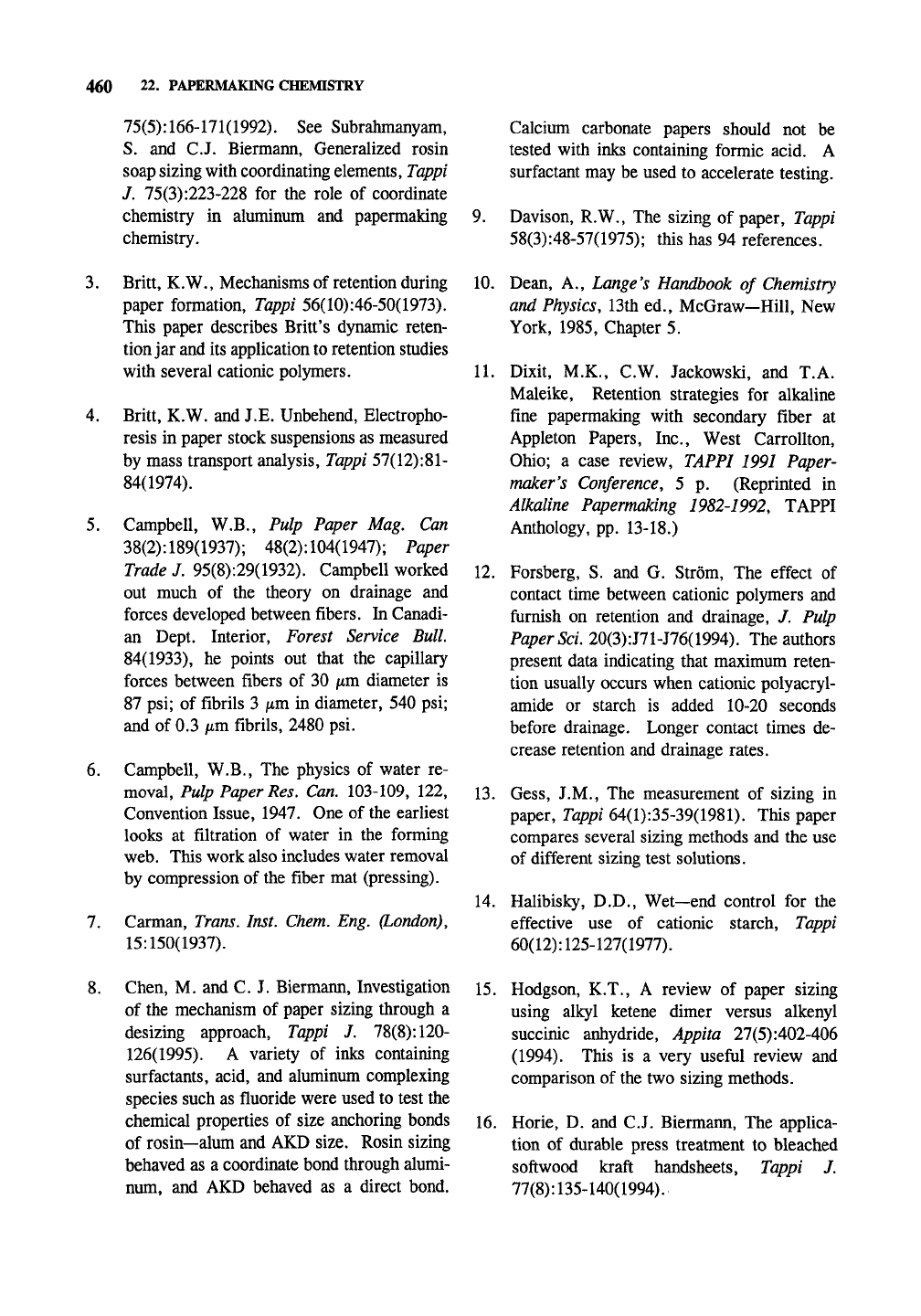
460
22.
PAPERMAKING CHEMISTRY
75(5):
166-171(1992).
See Subrahmanyam,
S. and C.J. Biermami, Generalized rosin
soap sizing with coordinating elements, Tappi
7.
75(3):223-228 for the role of coordinate
chemistry in aluminum and papermaking
chemistry.
3.
Britt, K.W., Mechanisms of retention during
paper formation, Tappi 56(10):46-50(1973).
This paper describes Britt's dynamic reten-
tion jar and its application to retention studies
with several cationic polymers.
4.
Britt, K.W. and J.E. Unbehend, Electropho-
resis in paper stock suspensions as measured
by mass transport analysis, Tappi 57(12):81-
84(1974).
5.
Campbell, W.B., Pulp Paper Mag. Can
38(2):
189(1937);
48(2):
104(1947);
Paper
Trade J. 95(8):29(1932). Campbell worked
out much of the theory on drainage and
forces developed between fibers. In Canadi-
an Dept. Interior, Forest Service Bull.
84(1933), he points out that the capillary
forces between fibers of 30 ptm diameter is
87 psi; of fibrils 3 jitm in diameter, 540 psi;
and of 0.3 iim fibrils, 2480 psi.
6. Campbell, W.B., The physics of water re-
moval. Pulp Paper Res. Can. 103-109, 122,
Convention Issue, 1947. One of the earliest
looks at filtration of water in the forming
web.
This work also includes water removal
by compression of the fiber mat (pressing).
7.
Carman, Trans. Inst. Chem. Eng. (London),
15:150(1937).
8. Chen, M. and C. J. Biermann, Investigation
of the mechanism of paper sizing through a
desizing approach, Tappi J.
78(8):
120-
126(1995). A variety of inks containing
surfactants, acid, and aluminum complexing
species such as fluoride were used to test the
chemical properties of size anchoring bonds
of rosin—alum and AKD size. Rosin sizing
behaved as a coordinate bond through alumi-
num, and AKD behaved as a direct bond.
Calcium carbonate papers should not be
tested with inks containing formic acid. A
surfactant may be used to accelerate testing.
9. Davison, R.W., The sizing of paper, Tappi
58(3):48-57(1975); this has 94 references.
10.
Dean, A., Lange's Hajidbook of Chemistry
and Physics, 13th ed., McGraw-Hill, New
York, 1985, Chapter 5.
11.
Dixit, M.K., C.W. Jackowski, and T.A.
Maleike, Retention strategies for alkaline
fine papermaking with secondary fiber at
Appleton Papers, Inc., West Carrollton,
Ohio;
a case review, TAPPI 1991 Paper-
maker's Conference, 5 p. (Reprinted in
Alkaline Papermaking 1982-1992, TAPPI
Anthology, pp. 13-18.)
12.
Forsberg, S. and G. Strom, The effect of
contact time between cationic polymers and
furnish on retention and drainage, J. Pulp
Paper
Sci.
20(3):J71-J76(1994). The authors
present data indicating that maximum reten-
tion usually occurs when cationic polyacryl-
amide or starch is added 10-20 seconds
before drainage. Longer contact times de-
crease retention and drainage rates.
13.
Gess, J.M., The measurement of sizing in
paper, Tappi 64(1):35-39(1981). This paper
compares several sizing methods and the use
of different sizing test solutions.
14.
Halibisky, D.D., Wet—end control for the
effective use of cationic starch, Tappi
60(12):
125-127(1977).
15.
Hodgson, K.T., A review of paper sizing
using alkyl ketene dimer versus alkenyl
succinic anhydride, Appita 27(5):402-406
(1994).
This is a very useful review and
comparison of the two sizing methods.
16.
Horie, D. and C.J. Biermann, The applica-
tion of durable press treatment to bleached
softwood kraft handsheets, Tappi J.
77(8):
135-140(1994).
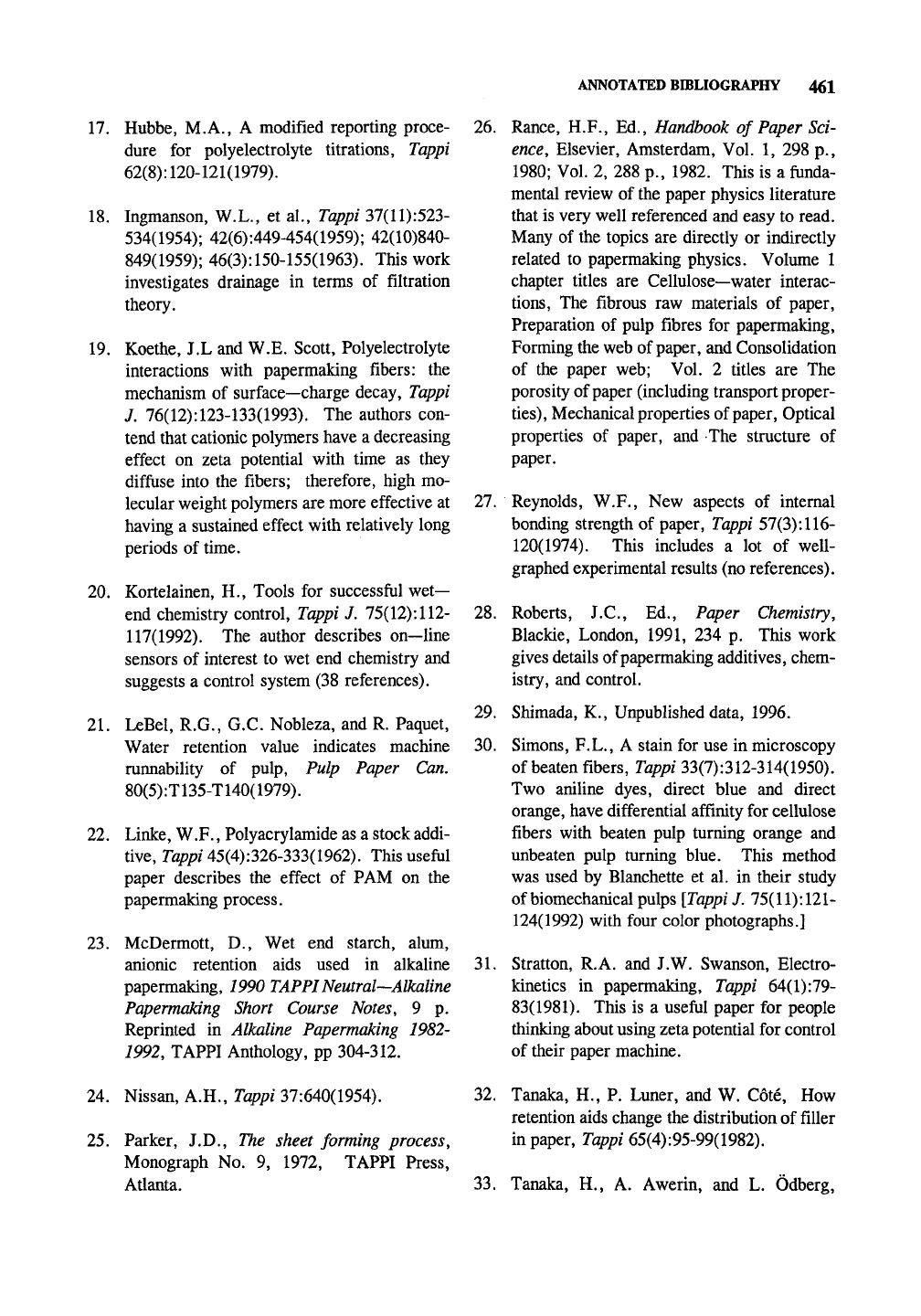
ANNOTATED BIBLIOGRAPHY 461
17.
Hubbe, M.A., A modified reporting proce-
dure for polyelectrolyte titrations, Tappi
62(8):
120-121(1979).
18.
Ingmanson, W.L., et al., Tappi 37(11):523-
534(1954); 42(6)-.449-454(1959); 42(10)840-
849(1959);
46(3):
150-155(1963).
This work
investigates drainage in terms of filtration
theory.
19.
Koethe, J.L and W.E. Scott, Polyelectrolyte
interactions with papermaking fibers: the
mechanism of surface—charge decay, Tappi
J.
76(12):
123-133(1993).
The authors con-
tend that cationic polymers have a decreasing
effect on zeta potential with time as they
diffuse into the fibers; therefore, high mo-
lecular weight polymers are more effective at
having a sustained effect with relatively long
periods of time.
20.
Kortelainen, H., Tools for successful wet-
end chemistry control, Tappi J.
75(12):
112-
117(1992). The author describes on—line
sensors of interest to wet end chemistry and
suggests a control system (38 references).
21.
LeBel, R.G., G.C. Nobleza, and R. Paquet,
Water retention value indicates machine
runnability of pulp, Pulp Paper Can.
80(5):T135-T140(1979).
22.
Linke, W.F., Polyacrylamide as a stock addi-
tive,
ra/7;7/45(4):326-333(1962). This useful
paper describes the effect of PAM on the
papermaking process.
23.
McDermott, D., Wet end starch, alum,
anionic retention aids used in alkaline
papermaking, 1990 TAPPI Neutral—Alkaline
Papermaking Short Course Notes, 9 p.
Reprinted in Alkaline Papermaking 1982-
1992,
TAPPI Anthology, pp 304-312.
24.
Nissan, A.H., Tappi 37:640(1954).
25.
Parker, J.D., The sheet forming process,
Monograph No. 9, 1972, TAPPI Press,
Atlanta.
26.
Ranee, H.F., Ed., Handbook of Paper Sci-
ence, Elsevier, Amsterdam, Vol. 1, 298 p.,
1980;
Vol. 2, 288 p., 1982. This is a funda-
mental review of the paper physics literature
that is very well referenced and easy to read.
Many of the topics are directly or indirectly
. related to papermaking physics. Volume 1
chapter titles are Cellulose—water interac-
tions.
The fibrous raw materials of paper.
Preparation of pulp fibres for papermaking,
Forming the web of paper, and Consolidation
of the paper web; Vol. 2 titles are The
porosity of paper (including transport proper-
ties).
Mechanical properties of paper. Optical
properties of paper, and The structure of
paper.
27.
Reynolds, W.F., New aspects of internal
bonding strength of paper, Tappi
57(3):
116-
120(1974). This includes a lot of well-
graphed experimental results (no references).
28.
Roberts, J.C, Ed., Paper Chemistry,
Blackie, London, 1991, 234 p. This work
gives details of papermaking additives, chem-
istry, and control.
29.
Shimada, K., Unpublished data, 1996.
30.
Simons, F.L., A stain for use in microscopy
of beaten fibers, Tappi 33(7):312-314(1950).
Two aniline dyes, direct blue and direct
orange, have differential affinity for cellulose
fibers with beaten pulp turning orange and
unbeaten pulp turning blue. This method
was used by Blanchette et al. in their study
of biomechanical pulps
[Tappi
J.
75(11):
121-
124(1992) with four color photographs.]
31.
Stratton, R.A. and J.W. Swanson, Electro-
kinetics in papermaking, Tappi 64(1):79-
83(1981). This is a useful paper for people
thinking about using zeta potential for control
of their paper machine.
32.
Tanaka, H., P. Luner, and W. Cote, How
retention aids change the distribution of filler
in paper, Tappi 65(4):95-99(1982).
33.
Tanaka, H., A. Awerin, and L. Odberg,
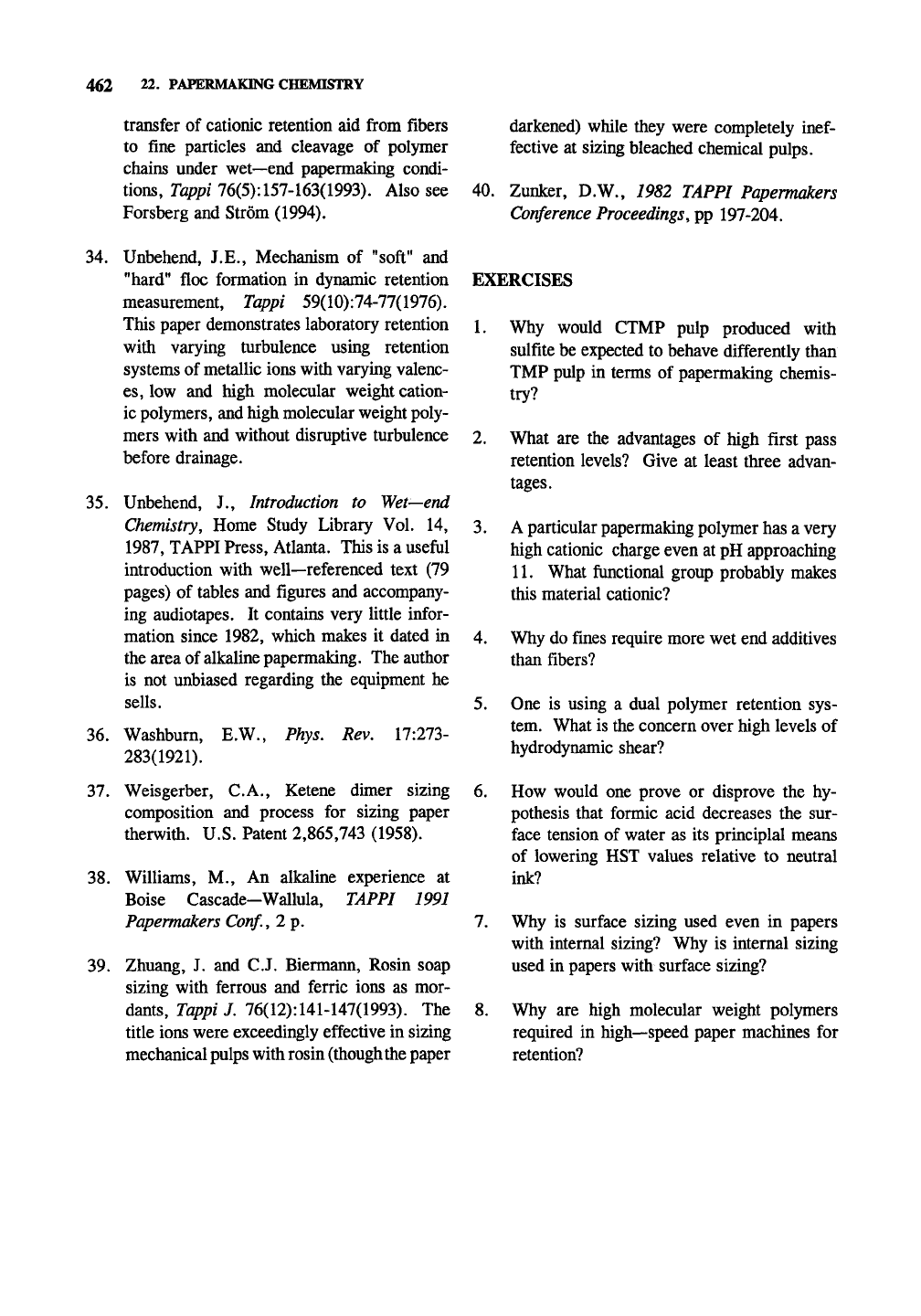
462 22. PAPERMAKING CHEMISTRY
transfer of cationic retention aid from fibers
to fine particles and cleavage of polymer
chains under wet—end papermaking condi-
tions,
Tappi
76(5):
157-163(1993). Also see
Forsberg and Strom (1994).
34.
Unbehend, J.E., Mechanism of "soft" and
"hard" floe formation in dynamic retention
measurement, Tappi 59(10):74-77(1976).
This paper demonstrates laboratory retention
with varying turbulence using retention
systems of metallic ions with varying valenc-
es,
low and high molecular weight cation-
ic polymers,
and
high molecular weight poly-
mers with and without disruptive turbulence
before drainage.
35.
Unbehend, J., Introduction to Wet—end
Chemistry, Home Study Library Vol. 14,
1987, TAPPI Press, Atlanta. This is a useful
introduction with well—referenced text (79
pages) of tables and figures and accompany-
ing audiotapes. It contains very little infor-
mation since 1982, which makes it dated in
the area of
alkaline
papermaking. The author
is not unbiased regarding the equipment he
sells.
36.
Washburn,
283(1921).
E.W., Phys. Rev, 17:273-
37.
Weisgerber, C.A., Ketene dimer sizing
composition and process for sizing paper
therwith. U.S. Patent 2,865,743 (1958).
38.
Williams, M., An alkaline experience at
Boise Cascade—Wallula, TAPPI 1991
Papermakers
Conf.,
2 p.
39.
Zhuang, J. and C.J. Biermann, Rosin soap
sizing with ferrous and ferric ions as mor-
dants,
Tappi J,
76(12):
141-147(1993). The
title ions were exceedingly effective in sizing
mechanical
pulps with rosin
(though the paper
40.
darkened) while they were completely
inef-
fective at sizing bleached chemical pulps.
Zunker, D.W., 1982 TAPPI Papermakers
Conference
Proceedings,
pp 197-204.
EXERCISES
1.
Why would CTMP pulp produced with
sulfite be expected to behave differently than
TMP pulp in terms of papermaking chemis-
try?
2.
What are the advantages of high first pass
retention levels? Give at least three advan-
tages.
3.
A particular papermaking polymer has a very
high cationic charge even at pH approaching
11.
What functional group probably makes
this material cationic?
4.
Why do fines require more wet end additives
than fibers?
5. One is using a dual polymer retention sys-
tem.
What is the concern over high levels of
hydrodynamic shear?
6. How would one prove or disprove the hy-
pothesis that formic acid decreases the sur-
face tension of water as its principlal means
of lowering HST values relative to neutral
ink?
7. Why is surface sizing used even in papers
with internal sizing? Why is internal sizing
used in papers with surface sizing?
8. Why are high molecular weight polymers
required in high—speed paper machines for
retention?

23
PRINTING AND THE GRAPHIC ARTS
23.1 INTRODUCTION
Papermakers must serve their customers and
know about their processes. Printing is one major
use of paper. Also, many paper converting op-
erations include printing.
International Paper (1983) is a useful (but
somewhat dated) reference on printing and provid-
ed some of the information included in this chap-
ter, although a 1989 edition exists. Glassman
(1985) is another excellent source of information.
In 1990, there were over 60,000 printing and
publishing establishments with 1.54 million em-
ployees of whom 818,000 were production work-
ers.
The annual payroll was $38.8 billion. The
total value of the publications was $157 billion.
Almost two—thirds of this was value added, a
very high ratio for any industry.
Historical context
Printing is often defined as "the use of ink to
transfer an image on a substrate such as paper"; it
implies the generation of a "large" number of
reproductions. The term "printing" was synon-
ymous for the letterpress method, which was
predominant until about 1940; now very little
letterpress printing is practiced. The use of
computers and instrumentation to generate material
must modify these traditional definitions and
implications.
Early letterpress plates were prepared by
carving wood plates corresponding to entire pages,
and these were of no use once the printing was
complete. The invention of movable type in the
western world is credited to Johannes Gutenberg
in Mainz, Germany in 1455; but a primitive
movable type made from metal was used in Korea,
China, and Japan several hundred years earlier.
Movable type consisted of individual letters
and characters that could be arranged to form an
individual line. Once a mold was made for a
particular letter, it could be filled with lead to give
the letter, cooled and separated, and filled again;
in this manner individual characters could be mass
produced. Lines of type were assembled to give
a page. When the printing job was completed, the
characters could easily be recovered for reuse.
The invention of Gutenberg's movable type was of
paramount importance to the development of
civilization, as the availability of printed material
increased by several orders of magnitude within a
relatively short period of time.
Another major advance was the invention of
linotype machines by Ottmar Mergenthaler, which
appeared in 1886. These machines automatically
assemble lines of tvpe as the characters are typed
in at a keyboard. Typesetting was common until
the late 1960s. The Linotype—Hell Company
licenses many fonts used in printing including
some used in computer printers.
Introduction
The various methods of printing high num-
bers of reproductions center on the plate which
carries the image to be printed. Plates may carry
type (text), pictures, or both (the copy material).
The purpose of the plate is to transfer the ink
(from the ink—fountain) in the form of an image
to the paper (perhaps through a blanket) to give a
clear copy of the image of interest. Three possi-
ble geometries are available and define the basic
processes (Fig. 23-1) of
letterpress,
raised printing
surface; lithography, printing and nonprinting
surfaces that are in the same plane; and gravure
(recessed printing surface). The fourth main
geometry is used in screen printing, which uses a
stencil or porous plate.
When an image is transferred by direct con-
tact, the image on the plate must be a mirror
image of the desired result. If one ink transfer is
used, the plate uses a positive image.
Many advances in printing have caused
conmion terms to be redefined. While the defini-
tion of the term was apparent at one time, the
present definition is not necessarily straightfor-
ward. A good example of this is the term ojfset.
When letterpress printing was common, offset
referred to the undesirable transfer of ink to the
blanket. In the early 1900s, it was found by
accident that when offset came in contact with
paper, a superior unage was produced. With that
463
